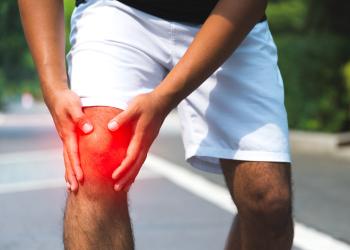EPAT - Shockwave Therapy
Extracorporeal Pulse Activation TechnologyWhy Choose EPAT?
Discover The BEnefits Of Shockwave Therapy
Extracorporeal Pulse Activation Technology (EPAT), sometimes referred to as ESWT or shock wave therapy, is an FDA approved treatment that can fix the root problem and not just the symptoms. The technology is able to make changes at the cellular level, thus helping to re–educate dysfunctional tissue. This can speed up the healing process and decrease pain 40-50% faster. Decrease rehab time for sprains and strains. And can also be helpful with pain reduction and improving tissue mobility.
What is EPAT?
EPAT is the most advanced and highly effective non-invasive treatment method cleared by the FDA. This proprietary technology is based on a unique set of pressure waves that stimulate metabolism, enhance blood circulation, and accelerate the healing process. It can set off a cascade of biological responses across cellular, tissue, and organ levels. Applying shockwave in treatment stimulates regeneration and awakens the body’s natural healing system. This approach yields multiple advantages, including heightened collagen synthesis, cellular proliferation, accelerated wound healing, pain reduction, neovascularization, and diminished inflammation.
On a cellular level, the theory is that the constant firing (tightening) of the muscle leads to the fixation of the actin and myosin in the muscle fibers. The shockwave will break this cycle, so the muscle can start to relax, which then improves blood flow circulation, dilutes those sensitizing inflammatory substances within the muscle as pain modulation and then leads to a compromise of these damaged muscle fibers.
Biological Effects of EPAT
Shockwave will induce a variety of biological reactions resulting from the shear and pressure forces they produce. This mechanism of action is referred to as mechanotransduction. The following effects have been investigated and confirmed in scientific studies:
- Increase in cell permeability
- Stimulation of microcirculation (blood, lymph)
- Release of substance P
- Reduction of non-myelinated nerve fibers
- Release of nitric oxide (NO), which leads to vasodilation, increased metabolic activity
and angiogenesis and has an anti-inflammatory effect.
- Antibacterial effect
- Release of growth hormones (blood vessels, epithelium, bones, collagen, etc.
- Stimulation of stem cells

Shockwave vs Ultrasound: What’s the difference?
While both focused shockwave and ultrasound share similarities, they have some key differences. Focused shock waves pack much more intense press, causing rapid changes in the medium they pass through, such as water and human tissue. On the other hand, ultrasound waves are usually regular vibrations with a limited range of frequencies. These vibrations lose energy as they move through the tissue resulting in an increase in temperature. Conversely, focused shockwaves are characterized by a single strong pulse followed by a comparatively small tensile wave component (negative pressure pulse). Such a pulse contains a wide range of frequencies and does not cause a rise in tissue temperatures.
What Can EPAT Be Helpful With?
Extracorporeal Shockwave Therapy gets to the root cause of the dysfunction and accelerates healing of acute and chronic issues stemming from musculoskeletal pain or restrictions. These areas include:

Achilles Tendinopathy
Repetitive minuscule injuries and tears to the tendon fibers take an enormous toll on the Achilles tendon and the athlete enduring the injury. Athletes who suffer from Achilles tendinopathy may experience pain, swelling, stiffness, and limited mobility.
Using Extracorporeal Shockwave Therapy for Achilles tendinopathy is exceptionally effective. Explore the evidence to see how you can help athletes in your care score functional gains – quickly and efficiently; read this study.

Tennis or Golfers Elbow
Lateral epicondylitis (Tennis elbow) and medial epicondylitis (Golfer’s elbow) are common inflammatory conditions triggered by repetitive motion. Both are prevalent among athletes, and they can benefit from shockwave therapy.

Stress Fractures
Bone stress injuries (BSI) frequently plague runners, and due to the associated prolonged time necessary away from sport, the toll it takes is physically and mentally impactful. And while the diagnosis is disheartening, shockwave offers new hope. “A recent retrospective study” by Alexander Beling, MD, Amol Saxena, DPM, Karsten Hollander, MD, and Adam S.Tenforde, MD, explores the effectiveness of ESWT in the management of BSI in runners.

Frozen Shoulder
People 40 and older, particularly women, or people who have had to keep their shoulder immobile (i.e. post-surgery) for an extended period, are more likely to have frozen shoulder. The severity of the frozen shoulder will dictate the approach to shockwave therapy. Although the jury is still out on the outcomes, EPAT will effectively address the broader area, and will treat the shoulder in a more focused manner.

Plantar Fasciitis
This inflammatory condition is commonplace in athletic populations and causes severe heel and arch pain; with particularly acute symptoms upon rising or taking that first step out of bed in the morning. The plantar fascia, which connects the heel bone to the toes, becomes inflamed and is exacerbated by overuse. This condition is excruciating and can sideline athletes because even standing and walking is difficult, never mind performing at a high level. Fortunately, the efficacy of Extracorporeal Shockwave Therapy for Plantar fasciitis is well-established and proven by multiple clinical trials and meta-analyses, and here’s one to explore.

Rotator Cuff Injuries
Rotator cuff injuries can be acute or chronic. Usually, the pain increases at night, and the presence of shoulder weakness is part of the symptom profile. Calcium deposits may also form on the shoulder tendon.

Strained Calves or Hamstrings
These injuries are high on the list of conditions among athletes of all ages, and published studies prove the efficacy of ESWT for both calf strains hamstrings

Shin Splints
Considered a painful condition, shin splints occur from inflammation in the muscles, tendons, and tissues surrounding the tibia. Also referred to as Medial tibial stress syndrome, it was one of 8 functional lower limb injuries explored in a study focused on the effectiveness of shockwave therapy, and it was determined that ESWT delivers multiple effects contributing to tissue healing and pain relief.

Hip Pain
Hip pain in athletes comes in many forms, and Extracorporeal Shockwave Therapy has been shown to greatly alleviate hip pain. https://pubmed.ncbi.nlm.nih.gov/19439758/

Jumper’s Knees
Another frequently seen overuse injury which can develop slowly over time and become chronic. The results are in – Extracorporeal Shockwave Therapy demonstrated greater effectiveness and safety compared to traditional conservative approaches to chronic patellar tendinopathy.
What Are the expected results?
Some patients report immediate pain relief after the treatment, although it can take up to four weeks for pain relief to begin. The procedure eliminates pain and restores full mobility, thus improving your quality of life. Over 80% of patients treated report to be pain free and/or have significant pain reduction.
Is it safe?
Yes. This FDA cleared technology was developed in Europe and is currently used around the globe. A wealth of medical experience, state-of-the-art engineering and optimal quality have been built into each EPAT device, and extensive clinical studies and tests have confirmed its safety and efficacy.
What is the duration of the treatment and how many treatments will I need?
Treatment sessions take approximately 10-15 minutes depending on the disorder to be treated. Generally, at least 3-5 treatment sessions are necessary at weekly intervals.
What are the possible side effects or complications?
The non-invasive EPAT treatment has virtually no risks or side effects. In some cases, patients may experience some minor discomfort which may continue for a few days. It is normal to have some residual pain after intense exercise or a full day of work.
What if I have a special health condition?
The safety and effectiveness of the EPAT procedure has not been determined on people with the following health conditions. Your doctor will provide you with information about how these and other conditions might affect the determination to perform the EPAT procedures.
• Malignancies
• DVT (Deep Vein Thrombosis)
How is the treatment performed?
Coupling gel is applied to the treatment area of interest to enhance effectiveness. After these preparations, EPAT pressure waves are released via the applicator moved over the area of interest in a circular motion.
Why consider non-invasive EPAT?
EPAT has a proven success rate that is equal to or greater than that of traditional treatment methods (including surgery) and without the risks, complications, and lengthy recovery time.
EPAT is:
• Performed in your physician’s office/ clinic
• Does not require anesthesia
• Requires a minimal amount of time
Patients can:
• Bear weight (i.e. walk) immediately,
• Return to work/normal activities within 24-48 hours
• Resume strenuous activities after 4 weeks.
is EPAT covered by insurance?
No. However, comparing the potential cost of EPAT (Extracorporeal Pulse Activation Technology) with other treatment options for musculoskeletal ailments—including surgery, corticosteroid injections, PRP (Platelet-Rich Plasma therapy), and stem cell injections—requires considering several factors. These factors include the specific condition being treated, geographic location, provider rates, and insurance coverage.
EPAT (Extracorporeal Pulse Activation Technology)
- Cost Range: Patients might pay between $125 and $250 per session for EPAT, with a typical course of treatment involving 3 to 5 sessions, totaling between $375 and $1,250.
- Insurance Coverage: EPAT is not covered by insurance, leading to out-of-pocket expenses for patients.
Surgery
- Cost Range: Depending on the surgery’s complexity, associated hospital fees, anesthesia, and post-operative care, costs can range from several thousand dollars to over $50,000.
- Insurance Coverage: Surgical treatments are frequently covered by insurance, though deductibles and copays can significantly affect out-of-pocket costs.
- Factors for rehab: Surgical intervention is invasive and often unwarranted for the conditions most commonly addressed with EPAT. Furthermore, return to activity is typically much longer.
Corticosteroid Injections
- Cost Range: The cost for these injections typically ranges between $100 and $300 per injection, with some conditions requiring multiple injections.
- Insurance Coverage: Corticosteroid injections are usually covered by insurance, subject to deductibles and copayments.
- Factors for rehab: Corticosteroid injections may or may not assist in ones ability to progress with their rehab, have potentially detrimental effects on the surrounding tissues and do not aid in the healing of the injured tissue.
PRP (Platelet-Rich Plasma Therapy)
- Insurance Coverage: PRP therapy is not commonly covered by insurance plans, making it an out-of-pocket expense for most patients.
- Cost Range: PRP treatments cost between $500 and $2,500 per injection, with some conditions necessitating multiple treatments.
Stem Cell Injection
- Cost Range: Stem cell therapy is one of the more expensive options, with costs ranging from $2,000 to $10,000 per injection, depending on the type of stem cells used and the treatment’s complexity.
- Insurance Coverage: Like PRP, stem cell injections are typically not covered by insurance, representing a significant out-of-pocket expense.
No. However, comparing the potential cost of EPAT (Extracorporeal Pulse Activation Technology) with other treatment options for musculoskeletal ailments—including surgery, corticosteroid injections, PRP (Platelet-Rich Plasma therapy), and stem cell injections—requires considering several factors. These factors include the specific condition being treated, geographic location, provider rates, and insurance coverage.
EPAT (Extracorporeal Pulse Activation Technology)
- Cost Range: Patients might pay between $125 and $250 per session for EPAT, with a typical course of treatment involving 3 to 5 sessions, totaling between $375 and $1,250.
- Insurance Coverage: EPAT is not covered by insurance, leading to out-of-pocket expenses for patients.
Surgery
- Cost Range: Depending on the surgery’s complexity, associated hospital fees, anesthesia, and post-operative care, costs can range from several thousand dollars to over $50,000.
- Insurance Coverage: Surgical treatments are frequently covered by insurance, though deductibles and copays can significantly affect out-of-pocket costs.
- Factors for rehab: Surgical intervention is invasive and often unwarranted for the conditions most commonly addressed with EPAT. Furthermore, return to activity is typically much longer.
Corticosteroid Injections
- Cost Range: The cost for these injections typically ranges between $100 and $300 per injection, with some conditions requiring multiple injections.
- Insurance Coverage: Corticosteroid injections are usually covered by insurance, subject to deductibles and copayments.
- Factors for rehab: Corticosteroid injections may or may not assist in ones ability to progress with their rehab, have potentially detrimental effects on the surrounding tissues and do not aid in the healing of the injured tissue.
PRP (Platelet-Rich Plasma Therapy)
- Insurance Coverage: PRP therapy is not commonly covered by insurance plans, making it an out-of-pocket expense for most patients.
-
Cost Range: PRP treatments cost between $500 and $2,500 per injection, with some conditions necessitating multiple treatments.
Stem Cell Injection
- Cost Range: Stem cell therapy is one of the more expensive options, with costs ranging from $2,000 to $10,000 per injection, depending on the type of stem cells used and the treatment’s complexity.
- Insurance Coverage: Like PRP, stem cell injections are typically not covered by insurance, representing a significant out-of-pocket expense.


